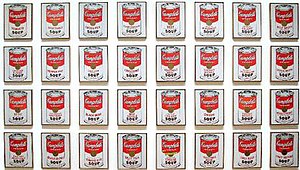From Wikipedia, the free encyclopedia
- See also: Campbell's Soup Cans (disambiguation)
 |
| Campbell's Soup Cans |
| Andy Warhol, 1962 |
| Synthetic polymer paint on canvas |
| 50.8 × 40.6 cm, 20 × 16 inches |
| Museum of Modern Art, New York, NY (32 canvas series displayed by year of introduction) |
Campbell's Soup Cans (sometimes referred to as 32 Campbell's Soup Cans) is the title of an Andy Warhol work of art that was produced in 1962. It consists of thirty-two canvases, each measuring 20 inches in height x 16 inches in width (50.8 x 40.6 cm) and each consisting of a painting of a Campell's Soup can—one of each canned soup variety the company offered at the time. The individual paintings were produced with a semi-mechanised silkscreen process, using a non-painterly style.
The work was Warhol's first one-man gallery exhibition as a fine artist.[1][2] The combination of the semi-mechanized process, the non-painterly style, and the commercial subject initially caused offense, as the work's blatantly mundane commercialism represented a direct affront to the technique and philosophy of Abstract expressionism. The latter art movement was dominant during the post-war period, and it held not only to "fine art" values and aesthetics but also to a mystical inclination. This controversy led to a great deal of debate about the merits and ethics of such work. Warhol's motives were questioned (they continue to be topical to this day). The public commotion helped transition Warhol from being an accomplished 1950s commercial illustrator to a notable fine artist, and it also helped distinguish him from other rising pop artists. Although commercial demand for his paintings was not immediate, his association with his subject was: Warhol's name became synonymous with his Campbell's Soup Can paintings.
Warhol subsequently produced a wide variety of art works depicting Campbell's Soup cans (his career went through three distinct phases in which he expended a great deal of effort in this area), as well as other works using a variety of images from the world of commerce and mass media. Today, the Campbell's Soup Cans theme is generally used in reference to the original set of paintings as well as all subsequent Warhol drawings and paintings depicting Campbell's Soup cans. As a result of the eventual popularity of the entire series of similarly themed works, Warhol's reputation grew to the point where he was not only the most-renowned American pop art artist,[3] but also the highest-priced living American artist.[4]








